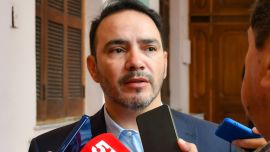None of the numbers in last Sunday’s provincial elections carried the impact of the 8.4 percent April inflation figure announced on the cusp of that weekend, perhaps not so much for that statistic as such with its alarming acceleration as for the government reactions turning some of the most central pillars of Kirchnerite economics on their head – sharply upping interest rates when the focus on consumer-led growth dictates that they be negative in order to encourage people to spend not save (compounded by the fiscal need for sales taxation with drought-stricken export duties slumping) and proposing food imports (in an agricultural heavyweight acutely lacking dollars) when protectionism is axiomatic.
Nor did the confirmation of gubernatorial continuity in the three elections compete for the week’s main headlines with Vice-President Cristina Fernández de Kirchner’s ratification of no direct presence in this year’s campaign, thus wrong-footing the Peronist party congress assembling the same day to advance a “Draft Cristina” drive. But not really news, despite the accompanying spleen, so today’s column will focus on those elections.
That voting failed to grab much nationwide attention, given three remote provinces housing little more than four percent of the Argentine population – the country’s two smallest electorates plus Salta’s seven-digit voter total – renewed the same three faces as before yet there are some revealing details behind the main results. For most people this story will begin and end with the news that all three governors – La Pampa’s Sergio Ziliotto, Salta’s Gustavo Sáenz and Tierra del Fuego’s Gustavo Melella, all more or less aligned with the Frente de Todos government but none of them running under that label – were re-elected comfortably enough, although with reduced percentages in all three cases. But their rivals are also worth a closer look to see how much they reflect national trends.
National party lines were especially confounded in the most important of these provinces, Salta, where there were a dozen gubernatorial candidates. Starting with the winner, Sáenz (Economy Minister Sergio Massa’s 2015 running-mate), whose support straddling the grieta chasm was so hodgepodge that he could find no better name for his list than the ultra-personalist “Gustavo Gobernador” – a moderate Peronist core but also other backers from all sides, including elements from the main opposition parties, PRO (especially linked to Buenos Aires City Mayor Horacio Rodríguez Larreta) and the Radicals. The fragmented opposition helped Sáenz increase his 2019 margin by three points but at the same time his vote fell by six points (from 53.6 to 47.5 percent).
The runner-up in Salta with 17.3 percent was the Radical deputy Miguel Nanni, the official candidate for the national Juntos por el Cambio opposition, but Emiliano Estrada in third place (16.1 percent) was the most intriguing rival as a holdall receptacle for political strays and opportunists. Arriving from Eduardo ‘Wado’ de Pedro’s Interior Ministry, he represented Kirchnerite purism and La Cámpora but somehow managed to team up with two different extreme right strands averse to supporting either the provincial government or Juntos por el Cambio – Javier Milei’s libertarians and the local quasi-fascist ex-deputy Alfredo Olmedo (some people might argue that libertarianism and fascism are the same things from their common home in the far right, but doctrinally at least they are almost opposites). This led various media pundits, especially those obsessed with the “Milei phenomenon,” to present the Estrada vote of 16 percent as another alarm bell but it was far more complex.
This still leaves around 20 percent of the Salta vote for the nine also-rans. The most successful were the Peronists Walter Wayar, lieutenant-governor of the centre-right ex-governor Juan Carlos Romero (now a Juntos por el Cambio senator) throughout his three terms, with 5.1 percent and deputy Verónica Caliva representing a more feminist wing of Frente de Todos with 2.6 percent. The FIT-MST leftist candidate Claudio del Plá only garnered 2.1 percent of the vote, partly because there were three other extreme left splinters occupying the bottom three places chipping away at his vote. This leaves three other candidates with no clear alignment, of whom Lucas Posse (Salta con vos) was the most successful with 2.6 percent.
Even accepting the equation of Estrada votes with Milei in Salta, Tierra del Fuego presents clear counter-evidence against overrating the libertarian threat. Why? Because despite Milella’s absolute majority (51.3 percent), the real star at the bottom of the country was the blank vote accounting for 21.7 percent of the ballots cast, almost thrice the 7.1 percent for the libertarian candidate, the evangelical preacher Ana Almirón de Pauli. Assuming blank ballots to be protest votes, it would thus be risky to conclude that all the latter are automatically heading for Milei – if three-quarters of the disenchanted in Tierra del Fuego preferred to vote blank than for an explicitly libertarian candidate, who is to say this might not be replicated nationwide?
If Milella expanded his 2019 margin from 15 to 40 points, despite receiving almost four percent fewer votes, this was because the Juntos por el Cambio vote was split between PRO deputy Héctor Stefani (11 percent) and Radical Senator Pablo Blanco (5.6 percent), the official opposition candidate also backed by PRO chair on leave Patricia Bullrich. The only other candidate was Partido Obrero Trotskyist Lucía Fernández (three percent). The mayors of the two main cities, Ushuia’s Wálter Vuolo and Río Grande’s Martín Pérez, both La Cámpora militants, were comfortably re-elected.
La Pampa was the simplest, most polarised and most contested of these three elections, perhaps as the only one to hold PASO primaries. Almost 90 percent of the vote went to the two main national coalitions – 47.6 percent for re-elected Peronist Governor Ziliotto, thus maintaining his party’s unbeaten streak since 1983, and 42 percent for Radical deputy Martín Berhongaray. Most of the other votes (6.9 percent) went to independent Peronist Juan Carlos Tierno, a former Santa Rosa mayor representing ex-governor Carlos Verna, while a Trotskyist and the local provincial party notched just over one percent and a picket even less.
With no more provincial elections until June 11 (Tucumán’s delayed polls and San Luis) next week’s column will take a break from local voting and return to the national scene.























Comments